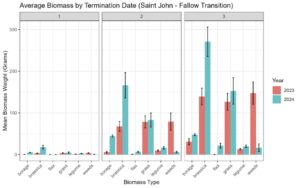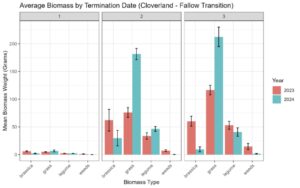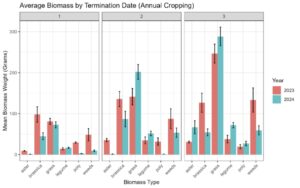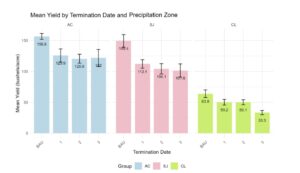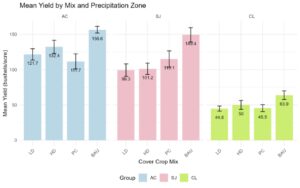Progress report for SW22-940
Project Information
This collaborative project uses replicated on-farm research trials in combination with online information delivery to support adoption of cover cropping for inland Pacific Northwest (iPNW) dryland cereal-based cropping systems. Globally, cover cropping is a recognized strategy for mitigating soil erosion, loss of fertility and soil acidification, compromised soil health, reliance on synthetic inputs, and decreased biodiversity that jeopardize the sustainability of cropping systems. Despite these advantages, adoption of cover cropping has lagged in the iPNW relative to other regions. This is largely due to uncertainty regarding integrating cover crops into longstanding cereal-based crop rotations and how cover crop species perform for specific agronomic goals. In much of the region, low precipitation presents unique challenges to cover crop establishment and ensuring moisture sufficient for primary cash crops. Ongoing climatic challenges, including reduced summer precipitation and greater frequency of heat stress events, exacerbate these changes. The grower partners for this project (co-PIs and cooperators), all of whom are early adopters of cover cropping in the region, are motivated to diversify their production for the long-term benefits to soil health and resilience to climate variability and the potential to generate novel sources of income for their farms. They have expressed needs for research to help them and others succeed with cover crops in the iPNW, and participated in the design of this project’s three objectives: 1. Compare cover crop mixtures and termination dates for effects on cover crop performance, water infiltration rates, bulk density, nitrogen availability, weed and insect biodiversity and performance of the subsequent cash crop, 2. Compare the effects of treatments in Objective 1 on soil moisture profiles during the season and after different termination dates, 3. Use information from Objectives 1 and 2, existing published literature and data, and grower workshops and interviews to develop a comprehensive online support system for iPNW cover crop management. The system will include tools for deciding on what cover crops to plant and how to manage them, links to cover crop information and a platform for producer discussions and information sharing. The project will be the first of its kind to address key issues challenging cover cropping in iPNW cereal systems by providing key information needed for optimization and adoption. It is a crucial step toward improving soil health and the sustainability of these systems over the long run. This proposal is for a 3-year project, but we have also indicated the intent to carry it on for three additional years with additional funding to be requested in a proposal to WSARE.
1. Compare cover crop mixtures and termination dates for effects on cover crop performance, water infiltration rates,
bulk density, nitrogen availability, weed and insect biodiversity and performance of the subsequent cash crop
2. Compare the effects of treatments in Objective 1 on soil moisture profiles during the season and after different
termination dates
3. Use information from Objectives 1 and 2, existing literature and data, and grower workshops and interviews to develop the first comprehensive online support system for inland Pacific Northwest cover crop management
Project organizational meetings will include a launch meeting and annual project meetings in the first quarter of each year. Funds are requested for a project start in October of 2022. We will use the last quarter of 2022 for planning and to begin constructing the PaNDAS site. Plot establishment and assessments for Objectives 1 and 2 will take place in 2023-2025. In a fourth partial year (2025), data from the subsequent winter wheat will provide three full years of that assessment. Workshops to inform PaNDAS design will take place in the first winter (2023). Review of beta versions of PaNDAS site will be ongoing into 2024. A live version of PaNDAS will be launched in first quarter of 2024 and maintained through end of project. Funds will be sought to continue PaNDAS, which is conceived as a permanent, dynamic resource for producers. Each season, the project will be represented at field days and grower schools, and it will hold its own field day demonstration at two of its (AC and AC-F) sites.
Table 2. PaNDAS project timeline
Cooperators
- - Producer
- - Producer
Research
Research Objectives
The project addresses two key grower-identified questions through two objectives.
- Compare cover crop mixtures and termination dates for effects on cover crop performance, water infiltration rates, bulk density, nitrogen availability, weed and insect biodiversity and performance of the subsequent cash crop
- Compare the effects of treatments in Objective 1 on soil moisture profiles during the season and after different termination dates
Design and Treatments
Treatments will be applied in replicated trials on the eight working farms of the Producer Co-PIs and Producer Cooperators for this project. Four farms will be in the region’s lower precipitation Annual Crop-Fallow (AC-F) agroecological zone where business as usual (BAU) cropping consists of a three-year fallow-winter wheat-spring wheat rotation. Four farms will be in the higher precipitation annual cropping (AC) zone where BAU consists of a three-year rotation, predominantly spring legume-winter wheat-spring cereal. On each farm, nine strips (~ 0.5 ac. each) will be established within BAU fields, replacing fallow in AC-F and spring wheat in AC with experimental cover crop mixtures. A schematic of the plot design on a participating farm over three years is provided in Figure 1.
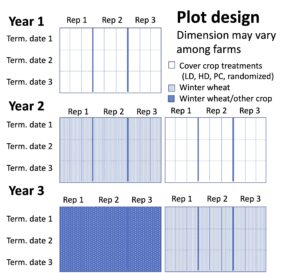
Cover Crop Mixtures. On each farm, three cover crop mixtures will be established, each with three replicate strips. Configuration will vary among farms to accommodate geometry and equipment. Common treatments will include a low-diversity cover crop mixture (LD) and a high-diversity cover crop mixture (HD). The LD mixture will include one grass, one legume and one brassica species in these proportions: 60% oats, 30% pea, and 10% turnip. The HD mixture will include three grasses (20% oats, 20% millet, 20% triticale), three legumes (10% pea, 10% sweet clover, 10% lentil), and three brassicas (3.3% turnip, 3.3% radish, 3.3% mustard). The third mixture on each farm will be a ‘producer’s choice’ (PC). We recognize that growers in different parts of the region, in addition to their common interests and questions about cover crops, have different challenges that influence their selection of cover crop mixes. The PC treatment will enable producers to test performance of a mixture designed based on their experience and interest. The findings about these mixtures will also inform our cover crop selection tool (see Objective 3). The PC mixtures and rationales for including them (Table 1) were developed as an outcome of a discussion involving all the cooperators and producer co-PIs for this project. Rationales common to several producers include nitrogen fertilization (4/8), weed suppression (4/8), bio-drilling (4/8, all in AC-F subregion), increasing organic matter (3/8), grazing income (2/8, both in the AC subregion). For this project, all three treatments will be established each year in the spring to improve comparability. There is also interest in fall planted cover crops in the region but evaluating those practices will be beyond the scope of this project.
Table 1 Producer-choice cover crops which will comprise the third treatment on each farm.
Termination Dates. Each of the standard treatments (HD and LD) and most of the PC treatments (see Table 1) will be terminated using herbicide in a split plot design on three dates based on cover crop vegetative growth profiles. Termination date 1 (TD1) will be on or before June 1, when cover crops are fully established and in accordance with USDA-NRCS guidelines and crop insurance program requirements. Termination date 2 (TD2) will be at first pod formation in any cover crop legume, and TD3 will be when all cover crops have reached maturity. The dates selected will maximize biomass production and related benefits to soil health while minimizing excessive moisture loss through transpiration and seed production leading to volunteer plants in the following. Producer-choice mixtures will also be terminated on these dates.
Subsequent Crop: Each year, strips will be relocated on each farm, marking their locations. In the subsequent cropping year, the ground with strips will be planted to winter wheat following standard grower procedures. The subsequent winter wheat crop yield and quality and soil nitrogen availability in near-surface soil will be measured in this follow-on wheat crop in the previous year’s cover crop and BAU strips to assess the effects of cover crops on the principal cash crop. Measurements to address Objective 1 and 2 on all farms will be as follows:
Objective 1. Cover Crop and Subsequent Cash Crop Performance: Cover crops will be evaluated for percent emergence and established stand diversity and cover crop coverage and biomass by species at each TD. In the second and third year of the project, the subsequent winter wheat will be assessed following cover crop and in the BAU system for emergence, stand, mature biomass, yield, grain moisture and protein.
Soil Physical Properties: Penetration resistance (Dane et al. 2002), bulk density (Grossman and Reinsch 2002), and water infiltration rates (van Es and Schindelbeck 2001) in cover crops at TD3 and in the subsequent winter wheat crops will be assessed to determine the impact of cover crops on soil physical properties. Penetration resistance measurements and infiltration rates will be measured once a year in cover crops and the following winter wheat crop. Bulk density measurements will be made prior to planting of the cover crops and at the end of the experiment.
Soil N and Organic Matter: Plant available nitrogen (Mulvaney 1996) in the first 1.5 m of soil will be measured in one TD in LD, HD and PC cover crop treatments at each site both in spring and at harvest. Three replicate, 1.5-m deep soil cores will be taken within each plot and split into 30-cm increments in the field. Subsamples from each depth increment will be combined to form one representative sample per treatment that will be analyzed. Changes in plant available nitrogen with depth, along with measured values of total nitrogen in above ground biomass, will be used to evaluate the impact of each cover crop treatment on nitrogen uptake and availability to the following crop. Sampling in the winter wheat crop will be limited to spring and results will be utilized to determine nitrogen fertilization application rates. Soil organic matter, estimated by loss on ignition (Nelson and Sommers 1996) will be assessed on the same samples collected to determine plant available nitrogen.
Weed and Insect Pressure and Biodiversity: Aphids (Aphididae; e.g., cereal aphids, pea aphid), wireworms (Elateridae), hessian fly (Mayetiola destructor), pea weevil (Bruchus pisorum), and pea leaf weevil (Sitona lineata) are some of the key insect pests in the iPNW. Additionally, several beneficial insects such as bees, wasps, flies, ladybug beetles, green lacewings are present in the region that need to be documented on cover crops. Similarly, key weeds are Mayweed chamomile (Anthemis cotula), cheat grass (Bromus tectorum), rattail fescue (Vulpia myuros), prickly lettuce (Lactuca serriola), common lambsquarters (Chenopodium album), and catchweed (Galium aparine). Baseline information of weeds, insect pests and beneficial insects within BAU and alternative cropping systems is important to understand the sustainability of future agricultural landscapes. Substantial changes in crop species and diversity could promote ecosystem services such as biological control and pollination, but also promote disservices by exacerbating existing pest populations or introducing new pests. To anticipate these potential effects, pests and beneficial organisms will be assessed in all treatments in the on-farm strip trials and in adjacent BAU crop fields. Briefly, weed abundance, coverage and diversity will be assessed before each termination dates in five 1-m2 quadrats in each cover crop strip and adjoining BAU fields during first two years, and in winter wheat following cover crops in the second and third years. Aboveground weed biomass will be assessed by clipping all plants rooted within quadrats, sorting to species, drying, and weighing. Following a similar schedule, insect pests and beneficials will be assessed on each strip using a D-Vac vacuum sampling along a W-shaped 30 m transect. Insect samples will be sorted to species for key pest species and beneficial insects to genus or family.
Objective 2. Sensors linked to data loggers (Acclima, Meridian ID) will continuously monitor volumetric soil moisture and temperature at two depths in each cover crop treatment at TD2 and TD3 in one replicate block per farm. There will be 14 probes per site, which include 2 probes in each LD, HD, and PC at both TD2 and TD3 as well as 2 probes in the BAU. As a complement, soil moisture will be measured gravimetrically based on soil samples at the beginning and end of each growing season in all plots on each farm, utilizing the same cores collected under Objective 1. Volumetric water contents will be calculated utilizing measured bulk density values. These measurements will allow assessment of water use and tradeoffs between soil moisture conservation and biomass production. Replicated gravimetric measurements will allow comparisons of treatments within and across farms. Continuous monitoring will provide new information on soil moisture dynamics to understand the origin of point measurement values and guide future efforts to identify optimal cover crop termination dates to balance benefits of biomass production and potential costs of cover cropping to the yield of subsequent cash crops in our region. Termination dates currently are determined by producers based on intuition, scantly replicated experience on individual farms and generally follow some aspect of cover crop phenology as an approximate guide. Some are incentivized to terminate early (before June 1) for crop insurance reasons. Data will be widely disseminated to stakeholders through our decision support system (see Objective 3). Results on termination after June 1 and before end of season will have relevance for those involved in advising on crop insurance policy requirements. Water infiltration rates will be measured in all treatments each spring and after the final TD. This measurement has been encouraged by producers who have seen evidence of water infiltration improvement after cover crops and are greatly interested in this output from the project. Under low rainfall, this can be critical for maximizing harvesting of precipitation for crop growth.
Analysis for Objectives 1 and 2
The effects of cover-crop treatment, nested within farm, on each response variable (soil biological, chemical and physical properties) will be analyzed with analysis of variance (ANOVA), multivariate analysis of variance (MANOVA), or mixed models with data transformed as required for each variable. For common cover crop treatments, the effects of farm site and production zone and their interaction on response variables will also be assessed. Specifically, differences in weed and insect abundance, species richness, diversity, and community composition will be analyzed using appropriate mix-effects ANOVA models and multivariate analysis such as Non-Metric Multidimensional Scaling (NMDS). We will test differences in weed and insect community structures between cover crop treatment and termination timing using Permutational Multivariate Analysis of Variance (PERMANOVA) of the dissimilarity matrix using the vegan package in R statistical software (R Core Team 2019, Oksanen et al. 2020). This will enable detection of effects that are broadly relevant in the iPNW across its precipitation regimes and those that are site or production class specific, critical information for guiding cover crop implementation and management. Summaries of all these findings will be distilled for presentation on the project’s PaNDAS website into thematic segments such as: “Terminating your cover crop to optimize water use”, “Best cover crop species for water conservation”, and “iPNW cover crops and weed suppression”. The findings will also be unique and publishable in refereed journals including Journal of Agronomy, Journal of Soil and Water Conservation, Applied Soil Ecology.
Farm sites in the 2023 and 2024 field seasons
Between the project start date and April 15, 2023, the specific plot locations were identified on each of the 8 farmer cooperator/co-PI farms (Fig. 2) and flagged for planting. First sets of plots were established instrumented, planted and monitored on all 8 farms in 2023 and second sets of plots were established, planted and monitored in 2024 field season on each farm. The second set was close to the first set, generally less than a mile distant. In 2024, data were taken on the follow-on BAU treatment (winter wheat) over the 2023 plots as well as from cover crops in the 2024 plots.
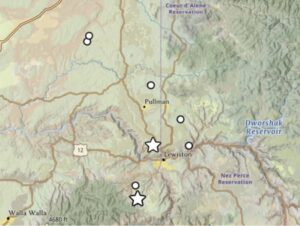
Operations conducted on each farm - Objective 1
Unless otherwise stated, the following procedures were followed on each set of plots in 2023 and 2024 field season.
Pre-plant (spring) and end of season soil samples were collected in the designated second termination date treatment strip of all plots and a BAU area adjacent to plots, in 30 cm increments from 0-150 cm for plant available soil N and gravimetric water content
- Seed for the common cover crop mixtures was procured and delivered to each farm in preparation for planting and all plots were seeded with cover crop mixes in April- May.
- Germination counts were completed within 2 weeks after seeding.
- Bulk density was measured only in the end of season soil samples in the termination date strip only of our cover crop plots, while collecting samples for soil N and gravimetric water content. This was only measured once due to time limitation in the spring, which is a deviation from what is stated in the last report under ‘Design and Treatments: Soil physical properties’.
- Infiltration was measured at two farms in 2023, one in each rainfall zone, after the final cover crop termination and in one farm in 2024. This is a very time consuming measurement to collect. We used a dual infiltrometer in attempt to get a more accurate reading than the simpler single ring infiltrometer. This original plan is stated in the last report under ‘Design and Treatments: Soil physical properties’ subheading and also mentioned under Objective 2.
-
Soil penetration resistance was not measured in spring 2023 during early cover crop growth. Instead we measured it in April-May 2024 to assess soil physical properties during the winter wheat phase, 1 year after cover crop treatments.
- Producers were not requested to adjust N fertilizer applications based on soil N tests as planned, but we will record rates used for the winter wheat planted on each farm.
- Cover crop and weed biomass were collected using three 0.5 m2 frames per each of nine plots across fields before each of the three crop termination dates.
- Insect samples were collected during the summers of 2023 and 2024 using 1800 standardized sweep net sampling (40 sweeps along a 40 m W-shaped transect per plot) for each of nine treatments and three BAU plots across eight producer cooperator fields during peak cover crop blooming (i.e., before the second or third crop terminations). The 2023 samples processing was completed in the laboratory and identified to family or the lowest possible classification. Data were analyzed using mixed-effects models and visualized using the ggplot2 package in R. The 2024 samples are currently being processed and identified, with the goal of completion before summer 2025.
- The 2023 cover crop plots were seeded to winter wheat in August-September 2023 and monitored to evaluate cover crop impact on winter wheat yield, N availability, and soil water availability in 2024. Seed zone moisture was measured at planting. In April 2024, soil N was measured in 0-30 and 30-60 cm increments, paired with winter wheat biomass and N-biomass content measurements.
- Winter wheat samples were collected by hand in July-August 2024 just before combine harvest. Samples were threshed to measure grain yield, grain protein and total crop biomass
- Cover crop biomass samples collected from 2023 were analyzed for total plant tissue N by plant family.
- Available soil N sample analysis (KCl extractable nitrate and ammonia) is ongoing from the more than 1,850 samples that were collected from plots in 2023-2024. Analysis of this data is forthcoming.
- Soil pH and has been measured on ¾ of sites, for soil characterization of each site. A pilot study of soils from 2 farms indicated no effect of cover crop on soil pH, though further analysis is underway
- Organic matter, measured as loss on ignition, is underway to compare baseline (pre-plant) to post-cover crop values. A pilot study is being conducted to determine the timeframe most appropriate for detecting changes in organic matter after cover crop treatments: end of cover crop growing season, spring following cover crops (~8 months), or 1 year following cover crops (end of winter wheat harvest).
Operations conducted on each of these sites - Objective 2
On cover crop plots, second set on each farm established in 2024:
- In the 2024 plots, cover crop and weed biomass was collected before each of the three termination dates. Cover crops were separated by plant family, dried and weighed. No sensors were installed in the 2024 cover crop plots. Instead, soil moisture was monitored gravimetrically in 30 cm increments from 0-150cm during pre-plant and post-harvest soil sampling, and in 0-30, 30-60, and 60-90 cm soil depths at each termination date. Additionally surface soil moisture, 0-10 cm, was measured with a handheld TDR probe at each termination date, and at winter wheat seeding in all 27 sub-plots per site in Sept-Oct 2024.
- Soil moisture and temperature sensors were installed were installed at all 8 farms prior to cover crop planting in 2023 and maintained throughout the winter wheat crop phase in 2024, providing continuous measurement of soil water availability in the cover crop treatments through winter wheat harvest in 2024.
- Data collection from these sens
On the follow-on winter wheat planted over 2023 cover crop plots:
- Soil moisture and temperature sensors were maintained throughout the winter wheat crop phase, providing continuous measurement of soil water availability in the cover crop treatments in 2023 through winter wheat harvest in 2024. Data collection from these sensors has continued to date.
- Seed zone moisture was measured at planting (Fall 2023).
- In April 2024, soil N was measured in 0-30 and 30-60 cm increments, paired with winter wheat biomass and N-biomass content measurements
- Soil penetration resistance was measured in April-May 2024 to assess soil physical properties 1 year after cover crop treatments.
- Winter wheat samples were collected by hand in July-August 2024 just before combine harvest. Samples were threshed to measure grain yield, grain protein and total crop biomass
- Soil N and gravimetric soil water samples were collected in 30 cm increments from 0-150 cm after winter wheat harvest.
Objective 1
Soil and crop responses
Above-ground dry biomass weight was collected in 2023 and 2024 and sorted by cover crop plant family and weeds and is summarized in Fig. 3. The Fallow transition zone is subdivided into 2 regions based on differences in mean annual precipitation (MAP) and correspondingly crop growth capacity. Saint John, WA, receives 30-45 cm MAP, and Cloverland, WA, receives ~ 25 cm MAP. At all sites and termination dates, weed biomass was lower in 2024 plots than 2023 plots. At the four Annual Cropping sites termination dates two and three, brassica species biomass was lower in 2024 than 2023, though the opposite was true for grass and legume species. In Saint John, brassica species biomass increased in 2024 compared to 2023, though grass and legume species biomass was similar among years. Similar to the Annual Cropping sites, in Cloverland, brassicas biomass was lower in 2024 than 2023, though grass species biomass was higher in 2024 than 2023. To clarify, since the plots were located in different fields in each year, differences across years is likely due to annual weather, management and/or field characteristics, and not an accumulative effect of consecutive cover crops.
Figure 3. Above-ground biomass of cover crop types and weeds in two regions over two years of the project. Left panels are sites in two regions within the Fallow Transition zone. Right panel is the average of sites in the Annual Cropping zone. Error bars represent standard deviations. See text above for additional information.
Winter wheat yield (bushels per acre) was generally lower following cover crops than following BAU crops when comparing by termination date or cover crop species mix (Fig. 4). While a yield reduction in the drier sites (SJ, CL) is not unexpected when replacing fallow with a crop due to potentially reducing soil moisture availability, the reduced yield in the Annual cropping sites, where soil moisture is generally less limiting, was not expected.
Figure 4. Yield (Bushels per Acre) in winter wheat following cover crops. Cloverland (CL) and Saint John (SJ) are reported separately again due to the difference in yield capacity between these sites in the Fallow Transition zone, while the mean for Annual Cropping zone (AC) is the mean of all sites in that zone. Labels: BAU = business as usual (no cover crop prior); 1, 2, 3 = Termination dates 1, 2, and 3 (see methods); LD = low diversity cover crop mix., HD = high diversity cover crop mix. PC = producer's choice cover crop mix. Error bars are xxx.
Weed and insect pressure and biodiversity
A total of 88,467 insect specimens were collected and identified from the sweep samples collected in 2023 from eight fields across three cover crop mix treatment and BAU plots (Total 192 samples = 8 fields X 2 sampling X 12 plots). Common insect groups, though they are not the major pests in the region, included thrips (42% of total specimens), plant bugs or Miridae (16%), leaf beetles or Chrysomelidae (9%), leafhoppers or Cicadellidae (5%), lygus bugs (5.5%), and caterpillars (3%) (Fig. 5). Generalist predators such as spiders, lady beetles, big-eyed bugs, minute pirate bugs, and damsel bugs accounted for 6% of the total specimens, while pollinators such as wasps, and hoverflies comprised 2% (Fig.5). Collectively, these groups accounted for more than 88% of total specimens.
We found consistently higher insect abundance in cover crop plots than in BAU fields (Fig. 5). In general, pests, predators, and pollinators were more abundant in plots with high-diversity cover crop mixes compared to those with low-diversity or producer’s choice cover crop mixes. Thrips, caterpillars, and plant bugs (Fig. 5), as well as total insect abundance in BAU plots, were higher in the annual cropping system compared to the annual transition cropping system. However, generalist insect predators and pollinators showed similar abundances between these cropping systems. There was no difference in the abundance of these beneficial insects among low-diversity, high-diversity, and producer’s choice cover crop mixes within either cropping system. However, thrips and plant bugs were more abundant in the low-diversity, high-diversity, and producer’s choice plots of the annual cropping system compared to those in the annual-transition system. Conversely, the annual transition cropping system had more generalist predators (beneficial insects) and fewer plant bugs (minor pests) compared to the annual cropping system (Fig. 5).

Objective 2
Effects of treatments in Objective 1 on soil moisture profiles
At the Annual cropping sites , the effect of termination date on effective soil water depth varied by farm (Fig. 6a). At Farm 1 (F1), soil water recharge was faster in both TD2 and TD3 than BAU at the end of the 2023 growing season, whereas at F3, cover crops terminated at TD3 used more water during the 2023 growing season and took longer to recharge over the winter than TD2 and BAU. In the Transition Fallow zone at the Cloverland sites Farms 5 and 6 (F5-F6, the driest region), there was more soil water stored in the BAU-fallow, compared to the cover crop plots throughout the 2023 growing season, and into winter months, with the most clear treatment effects between TD2 and TD3 at F6 (Fig. 6b). At the St. John sites, Farms 7 and 8 (F7-F8), cover crop affect on effective soil water depth was only observed at F7, where cover crops terminated at both TD2 and TD3 used similar amounts of soil water, leaving approximately 2 inches or less soil water compared to the quantity stored in BAU-fallow. This difference persisted until February of 2024, throughout the beginning months of winter wheat growth.

Effects of treatments in Objective 1 on soil physical properties - penetration resistance
Penetration resistance data was collected in the spring of 2024 in winter wheat following 2023 cover crops. Two measurements were collected from Termination Date 3, rep 3 plots, and BAU for all sites. In each plot, one measurement was taken from within the crop row of the planted winter wheat, and one between the crop rows of the winter wheat. Analysis of this data is ongoing.
Water infiltration data, standard soil sample soil moisture data were acquired and are still being analyzed as of this report.
Research Outcomes
Termination date guidance will require refinement. In year 1 we attempted to use a cover crop phenology indicator but that proved to be unreliable and variable among zones and farms. Cover crop termination guidance will need to be based on multiple cover crop species in case of polycultures. The use of glyphosate for termination of cover crops will affect timing of application because of a lag time from application to crop mortality.
Other recommendations from the project are pending more complete analysis of the 2023 field data and results of planned remaining field seasons.
Education and Outreach
Participation Summary:
The project has a social component in which participating producers were interviewed to determine their views on cover cropping, perceived barriers to adoption and challenges to implementing cover cropping in the cereal production systems of the inland PNW. In Dec. 2022, a semi-structured interview guide was designed with open-ended questions around: each operation context, producers' previous experiences with cover crops, expectations on the WSARE research project, cover crops benefits and concerns, and ideas for scaling up cover crop adoption in the inland Pacific Northwest.
The 8 in-person interviews were performed between December 2022 and January 2023. Each interview lasted approximately 1 hour, totaling 8h40m of content recorded. The 33-page report consists primarily of extracted quotes from subjects on a range of topics pertaining to cover cropping.
- Perceived benefits of cover crops
- Cover crop concerns
- Livestock on cover crops
- Producer expectations related to WSARE project
- Needs for scaling up cover crop in the inland Pacific Northwest
Palouse Alternative Cropping Symposia
2023
Palouse Alternative Cropping Symposium held on Feb. 24, in Colfax Washington. A presentation and data -gathering activity were conducted as a component of the Approximately 40 producers and 20 other persons were in attendance. These participants were provided with a quick overview of the interview based document followed by a data gathering activity using Menti-meter and prompts to garner views on cover crop challenges and benefits. Prompts included:
- How do you rate each of the following factors as a ‘+’ to ‘-‘ tradeoff you would (or are) experience by using cover crops?
- Which of the following best describes your view on the relation of livestock to cover cropping for this region?
- What factors need to be in the economic equation to assess cover crops? (7 words or less)
- How could your community benefit from expanding the use of cover crops?
- In your view, when do you expect to be the best time during the crop year to BOTH plant AND terminate a cover crop? (choose one)
2024
Palouse Alternative Cropping Symposium (PACS) in Colfax WA, Feb. 22 - Preliminary results and lesson’s learned from the 2023 season were shared by project members Kendall Kahl and Subodh Adhikari. Other project members and participants were there and engaged in discussions with stakeholders. The PACS had 70 participants: 15 producers and 55 from industry, agencies, the general public.
2025
Soil Health and Cropping Systems Tour, June 24 - Project members contributed to a presentation at one of the project's on-farm trials. A brochure is attached. Kendal Kahl and Subodh Adhikari, project PIs at the University of Idaho and Frank Wolf, producer project co-PI presented at project research site on Wolf's farm.
Palouse Alternative Cropping Symposium (PACS) in Colfax WA, Feb. 22. Project graduate student, Camilla Ditton and producer project co-PI Bruce Petty presented on "Impacts of cover crop mix and termination date on following cash crop" ads the Palouse Alternative Cropping Symposium (PACS). Presenters: Audience - 100 participants, including growers, ag professionals, agency, and University employees.
During the PACS meeting, seven grower-cooperators met with researchers to refine plans for the 2025 field season and consider possible research questions for a continuation of this project.
Website
A website was created that houses a resource hub for cover cropping in the inland PNW, a synopsis of the project design and objectives, a link to a page with project updates, a link to a registration to enter a discussion board with threads on cover cropping issues, currently: "Seeding spring cover crops"; "Diversifying farm operations", "Cover cropping", "Other topics for the project". This website was stood up and beta tested during early 2023, after which it was fully activated. It has been operational since early February 2023.
Podcasts
Two episodes of researcher and grower collaborators experience with PaNDAS project have been recorded, and are scheduled for release this spring. One episode features a conversation with researcher Subodh Adhikari and producer Frank Wolk, and the other features researcher Kendall Kahl and producer Clint Zenner.
Presentations with the title "WSARE Pacific Northwest Cover Crop Decision Aid System" with information about effects of cover crop mixes and termination dates on soil moisture, insects and weeds were made at Cereal Schools in northern Idaho: Greencreek ID, Jan. 27, Lewiston ID, Jan 28, Bonners Ferry ID, Jan. 31.
Annual Project Meetings
November 29, 2023 at the University of Idaho. Seven out of eight grower co-PI’s were in attendance, as well as all other project partners and contributors. Preliminary results and lesson’s learned from the first field season of research and insights from all attending growers were shared and discussed. Plans and adjustments to procedures for 2024 field season were discussed
December 5, 2024 at the University of Idaho. All eight grower-PI's attended, as well as other project partners and contributors. The meeting included an update from the research team and discussion and reflection from the grower PI’s perspectives. General consensus from growers that the second termination date seemed to be the ‘sweet spot’ for when to terminate. All grower PI’s committed to continuing the project with a second round of cover crop treatments in the current plots to provide valuable information. Research team committed to seek funding to keep this project going beyond the initial 3 years. Curiosity around cause of the lower winter wheat yields in 2024 following cover crops the previous year, but not overly concerned. Growers are interested in the cover crops for the long-term soil health benefits, and hope to see a benefit in yield. Growers expressed interest in using fall seeded cover crops in future treatments.
Reports of results of the producer interviews and the data gathered at the Palouse Alternative Cropping Symposium in 2023 were generated and posted to the project website: https://pnwcovercrops.org. In all years, PACS presentations were well received. The podcasts generated 279 and 206 listeners. Resources can be found at this link: https://www.pnwfarmersnetwork.org.
Education and Outreach Outcomes
None to report at this time.
